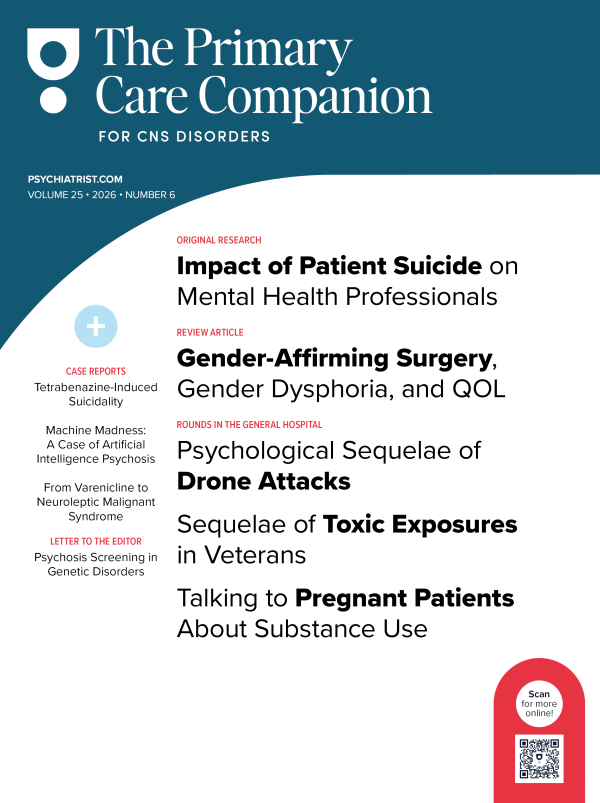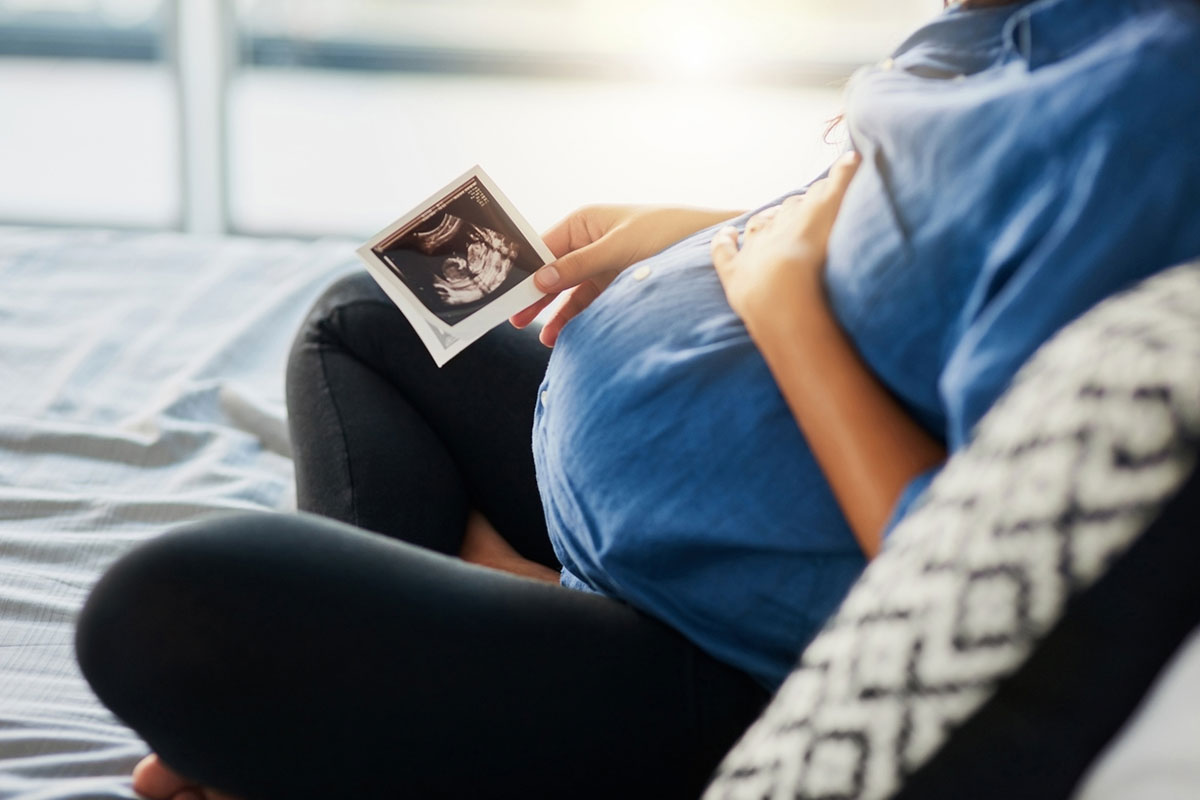Catatonia is a psychomotor syndrome characterized by a constellation of symptoms including immobility, stupor, or agitated excitement and is believed to involve alterations in γ-aminobutyric acid (GABA)ergic receptors in the brain.1 While there are limited data available on treating catatonia during pregnancy specifically, the treatment remains the same with benzodiazepines being the first line, followed by electroconvulsive therapy (ECT) if ineffective.1 Although ECT is a safe and effective treatment option for catatonia during pregnancy,2 its availability may be limited in different treatment settings. Therefore, benzodiazepines remain crucial due to their ease of administration, safety, and effectiveness.3 Recent literature has found no significant increase in major congenital malformations when using benzodiazepines in pregnant patients.4 Timely treatment of catatonia is crucial and outweighs the risk of exposure to the fetus.
Case Report
Ms A, a 38-year-old primigravid patient with a psychiatric history of schizoaffective disorder, presented in her third trimester after she was found wandering the streets, denying her pregnancy, lacking any prenatal care, and exhibiting catatonic symptoms including mutism, negativism, posturing, and agitation (Bush-Francis Catatonia Rating Scale score of 12) in the setting of psychosis secondary to medication nonadherence.5 She was treated with benzodiazepines after weighing the benefits of treatment versus the risks of untreated mental illness for mother and fetus, harm to self and others, and anticipated difficulty participating in the delivery of her baby while symptomatic. Our primary focus was a multidisciplinary approach, consisting of psychiatry, maternal fetal medicine (MFM), and obstetrics (OB) teams. Regular meetings were held to determine which interventions were emergent to prevent harm to the patient and fetus. As the psychiatric and labor and delivery units are in separate buildings, a contingency plan was made for safe transportation of the patient in coordination with nursing, mental health, and OB staff in case of pregnancy-related emergencies or onset of labor.
After the resolution of catatonia, Ms A was restarted on antipsychotics and, with the gradual resolution of the psychosis, began acknowledging her pregnancy and engaging in discussions about her fetus’s health. Our multidisciplinary care team transferred the patient from inpatient psychiatry to the OB floor to await delivery with consultation-liaison psychiatric follow-up. She subsequently had a normal vaginal delivery at term and was transitioned to a long-acting injectable antipsychotic.
Discussion
Catatonia is an important and underdiagnosed perinatal psychiatric emergency.6 Benzodiazepines are effective as positive allosteric modulators of GABA-A receptors and the first-line treatment for catatonia.3 While treatment pathways exist, limited data are available on approaching catatonia during pregnancy. Since ECT was unavailable at our institution, we treated our patient’s symptoms with benzodiazepines followed by antipsychotics, as untreated mental illness posed a greater risk to the patient and fetus than possible exposure to medications.
Recent studies have not found benzodiazepines to be teratogenic in early gestation.4 Our case highlights the need for an individualized and multidisciplinary approach to creating effective treatment plans for these patients. The patient faced obstacles including lack of prenatal care, denial of pregnancy, and inability to identify labor signs or receive medical attention. Her history of nonadherence to treatment suggested a high risk of decompensation if discharged directly from our inpatient psychiatric unit. Collaborative efforts among the psychiatry, OB/MFM, nursing, social work, and legal departments were critical in adapting the treatment plan to the patient’s evolving needs. This included management of psychosis from a psychiatric perspective, appropriate perinatal care from OB and MFM, social work’s coordination of care, and child protective services’ referral for safe disposition planning. To meet pregnant patients’ needs, an individualized and multidisciplinary approach is crucial for comprehensive care, and we strongly recommend its use as a standard approach when treating pregnant patients.
Article Information
Published Online: August 26, 2025. https://doi.org/10.4088/PCC.25cr03966
© 2025 Physicians Postgraduate Press, Inc.
Prim Care Companion CNS Disord 2025;27(4):25cr03966
Submitted: March 13, 2025; accepted May 29, 2025.
To Cite: Mohammad AA, Suleiman M, Klaine PP. It takes a village: a multidisciplinary approach to catatonia in pregnancy. Prim Care Companion CNS Disord 2025;27(4):25cr03966.
Author Affiliations: Department of Psychiatry, Maimonides Health, New York, New York (Mohammad, Suleiman, Klaine); Department of Psychiatry, NYU Grossman School of Medicine, New York, New York (Mohammad); Department of Psychiatry, Icahn School of Medicine at Mount Sinai, New York, New York (Suleiman).
Corresponding Author: Mariella Suleiman, MD, Department of Psychiatry, Maimonides Health, 927 49th St, Brooklyn, NY 11219 ([email protected]).
Relevant Financial Relationships: None.
Funding/Support: None.
Previous Presentation: Poster presented at the American Psychiatric Association Annual Meeting; May 21–25, 2022; New Orleans, Louisiana, and the New York State Psychiatric Association Seventh Annual Poster Competition; March 2022; New York, New York.
Patient Consent: Consent was received from the patient to publish the case report, and information has been de-identified to protect anonymity.
ORCID: Mariella Suleiman: https://orcid.org/0000-0001-8414-8843
References (6)

- Gonzales N, Quinn DK, Rayburn W. Perinatal catatonia: a case report and literature review. Psychosomatics. 2014;55(6):708–714. PubMed CrossRef
- Ward HB, Fromson JA, Cooper JJ, et al. Recommendations for the use of ECT in pregnancy: literature review and proposed clinical protocol. Arch Womens Ment Health. 2018;21(6):715–722. PubMed CrossRef
- Sienaert P, Dhossche DM, Vancampfort D, et al. A clinical review of the treatment of catatonia. Front Psychiatry. 2014;5:181. PubMed CrossRef
- Szpunar MJ, Freeman MP, Kobylski LA, et al. Risk of major malformations in infants after first-trimester exposure to benzodiazepines: Results from the Massachusetts General Hospital National Pregnancy Registry for Psychiatric Medications. Depress Anxiety. 2022;39(12):751–759. PubMed CrossRef
- Bush G, Fink M, Petrides G, et al. Rating scale and standardized examination. Acta Psychiatr Scand. 1996;93(2):129–136. PubMed CrossRef
- Hutner LA, Catapano LA, Nagle-Yang SM, et al. Textbook of Women’s Reproductive Mental Health. 1st ed. American Psychiatric Association Publishing;2022:1.
Please sign in or purchase this PDF for $40.





